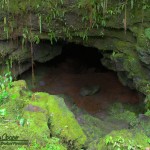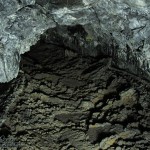A fern draped opening into the earth, that beckons us to explore what was once the domain of Pele. A place of fire and molten rock, now a cool, dripping passage beneath the earth. The island of Hawai’i is riddled with hundreds of miles of lava tubes, most are inaccessible, but some are easy to get to. Kaumana Cave is one of the easy ones.

Going makai, a short path leads to the entrance. There are a few boulders to step carefully through, after which sections of smooth and mostly level surfaces allow a bit easier access. About 50 yards into the downhill section you will reach a choke point, a little scrambling and a bit of duck-walk is necessary to get through. After the narrow, the cave opens back up again. After another hundred yards there are a series of ledges, old crusts left by cooling lava when it half filled the cave. To continue from here requires crawling through another very low passage. Perhaps a good place to turn around if you are only interested in a short exploration.
Entering the mauka side of the cave you find a very picturesque entrance providing access to a good sized chamber. Going beyond this entrance requires traversing a very low passage found under a wide ledge. After this the cave opens back up again.
The cave features a number of good lava tube features. Lavacicles are common, marking where molten rock dripped from the roof of the cave. Another common lava tube feature are gutters. Found at the side of the cave, rock trenches where a crust would partially form at the edge of the river of molten rock, flexing up and down with surges in the flow. Along the sides of the cave are lava-lines, areas of smoothed rock that mark the changing level of lava flowing through the cave.
Hanging throughout the cave are tree roots. Mostly ohia roots, they drape from the ceiling, carrying moisture and nutrients from the forest above. Living on the roots are unique insects and other arthropods, adapted to life in the cave.

The surveyed sections of the cave are over 25 miles long, few will expend the effort to explore the entire length. A few hundred yards is enough to get the feeling of the tube. Apparently, about five miles of cave are accessible via these entrances. Other sections are accessible via other entrances along the length of the 1881 lava flow. This includes Emesine Cave found much higher on the slopes of Mauna Loa.
When standing in the center of a lava tube I always take a moment to imagine the scene when the lava was still flowing. Beneath my feet a river of molten rock, chunks of crust and rocks fallen from the ceiling being carried along. A heat so intense the the sides and roof of the cave are still slightly molten, dripping into the flow below. This is a place no human could exist for more than a fleeting moment, a heat that would kill instantly. This is the scene that solidified in place, the last dregs of lava through the tube cooled in place, the river frozen for us to explore.
Exploring the lava tube requires sturdy footwear that will protect your feet from the very rough lava surfaces. At least two good, bright flashlights should be carried, a primary light and a backup light. The brighter the light, the better you will be able to see the cave. Modern high output LED flashlights are quite useful here. The cave is quite wet, expect to be dripped on the whole way and a bit damp upon exiting. While cool, the cave is not cold, perhaps consider a light jacket to keep the drips off.
Finding the cave is very easy, the entrance is directly beside Kaumana Drive and well marked. The location, just above the City of Hilo, is found on every island map and tourist guide. The cave entrance is part of a county park, with no admission fee, just park your car and explore.

